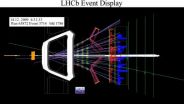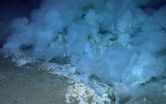(Press-News.org) Physicists in the College of Arts and Sciences at Syracuse University have made several important discoveries regarding the basic structure of mesons—subatomic particles long thought to be composed of one quark and one antiquark and bound together by a strong interaction.
Recently, Professor Tomasz Skwarnicki and a team of researchers proved the existence of a meson named Z(4430), with two quarks and two antiquarks, using data from the Large Hadron Collidor beauty (LHCb) Collaboration at CERN in Geneva, Switzerland. This tetraquark state was first discovered in Japan in 2007 but was later disputed by a team of researchers at Stanford University. Skwarnicki's finding was published earlier this month and has since garnered international publicity.
Quarks are hard, point-like objects that are found inside protons and neutrons and form the nucleus of an atom.
Now, another analysis by Syracuse University physicists—this one led by Distinguished Professor Sheldon Stone and his research associate Liming Zhang—shows two lighter, well-known mesons, originally thought to be composed of tetraquarks, that are structured like normal mesons.
Stone says that one of the particles, uniquely named the f0(980), was assumed to have four quarks because it seemed to be the only way for its mass to "make sense."
"The four-quark states cannot be classified within the traditional quark model, where strongly interacting particles [hadrons] are formed from either quark-antiquarks pairs [mesons] or three quarks [baryons]," says Stone, who also heads up Syracuse University's High-Energy Physics Group. "They are, therefore, called 'exotic particles.'"
Stone points out that his and Skwarnicki's analyses are not contradictory and, together, increase what physicists know about the strong interaction that forms the basis of what holds all matter together.
Stone's finding also changes what is known about charge-parity (CP) violation, the balance of matter and antimatter in the universe. That there is a small amount of excess matter (e.g., protons, neutrons and orbiting electrons) floating around in the ether implies that something other than the Standard Model of particle physics is at play.
"Fourteen billion years ago, energy coalesced to form equal quantities of matter and antimatter," Stone says. "But as the universe cooled and expanded, its composition changed. Antimatter all but disappeared after the Big Bang, leaving behind matter to create everything around us, from stars and galaxies to life on Earth. Something must have happened, during this process, to cause extra CP violation and, thus, form the universe as we know it. … The f0(980) is a crucial element in our studies of CP violation. Showing that it is not an exotic particle means we do not have to question the interpretation of our results."
Stone also hopes his findings may shed light on why heavy quarks are able to form four-quark particles and light ones cannot.
"How do you explain some of the interesting characteristics of f0(980), if it's not made of four quarks?" asks Stone, whose analysis also draws on LHCb data and has been submitted for publication.
Meanwhile, the tetraquark nature of Z(4430) also has huge implications for the study of neutron stars, remnants of gravitational collapses of massive stars.
"Everything we're doing at Syracuse University and CERN is pushing the boundaries of 'new physics,'" Stone says. "Because we're using large data sets, we have no choice but to use statistically powerful analyses that can measure particle properties in an unambiguous manner."
LHCb is an international experiment, based at CERN, involving more than 800 scientists and engineers from all over the world. At CERN, Stone heads up a team of 15 physicists from Syracuse University.
INFORMATION:
Syracuse University physicists confirm existence of new type of meson
2014-05-01
ELSE PRESS RELEASES FROM THIS DATE:
Investigators find something fishy with classical evidence for dietary fish recommendation
2014-05-01
Philadelphia, PA, May 1, 2014 – Oily fish are currently recommended as part of a heart healthy diet. This guideline is partially based on the landmark 1970s study from Bang and Dyerberg that connected the low incidence of coronary artery disease (CAD) among the Eskimos of Greenland to their diet, rich in whale and seal blubber. Now, researchers have found that Eskimos actually suffered from CAD at the same rate as their Caucasian counterparts, meaning there is insufficient evidence to back Bang and Dyerberg's claims. Their findings are published in the Canadian Journal ...
Atypical form of Alzheimer's disease may be present in a more widespread number of patients
2014-05-01
JACKSONVILLE, Fla. — Neuroscientists at Mayo Clinic in Florida have defined a subtype of Alzheimer's disease (AD) that they say is neither well recognized nor treated appropriately.
The variant, called hippocampal sparing AD, made up 11 percent of the 1,821 AD-confirmed brains examined by Mayo Clinic researchers — suggesting this subtype is relatively widespread in the general population. The Alzheimer's Association estimates that 5.2 million Americans are living with AD. And with nearly half of hippocampal sparing AD patients being misdiagnosed, this could mean that ...
JCI online ahead of print table of contents for May 1, 2014
2014-05-01
Balancing protein turnover in the heart
Alterations in the ubiquitin proteasome system (UPS), which tags proteins for degradation, underlies some cardiomyopathies and age-related cardiac dysfunction. In the heart, the UPS is essential for the precise balance between cardiomyocyte atrophy and hypertrophy. In skeletal muscle, the E3 ubiquitin ligase atrogin-1 promotes atrophy by targeting hypertrophy-associated proteins for degradation; however, a role for atrogin-1 in cardiac proteostasis is not clear. In this issue of the Journal of Clinical Investigation, Marco Sandri, ...
Undersea warfare: Viruses hijack deep-sea bacteria at hydrothermal vents
2014-05-01
More than a mile beneath the ocean's surface, as dark clouds of mineral-rich water billow from seafloor hot springs called hydrothermal vents, unseen armies of viruses and bacteria wage war.
Like pirates boarding a treasure-laden ship, the viruses infect bacterial cells to get the loot: tiny globules of elemental sulfur stored inside the bacterial cells.
Instead of absconding with their prize, the viruses force the bacteria to burn their valuable sulfur reserves, then use the unleashed energy to replicate.
"Our findings suggest that viruses in the dark oceans indirectly ...
Excessive regulations turning scientists into bureaucrats
2014-05-01
Excessive regulations are consuming scientists' time and wasting taxpayer dollars, says a report released today by the National Science Board (NSB), the policymaking body of the National Science Foundation and advisor to Congress and the President.
"Regulation and oversight of research are needed to ensure accountability, transparency and safety," said Arthur Bienenstock, chair of the NSB task force that examined the issue. "But excessive and ineffective requirements take scientists away from the bench unnecessarily and divert taxpayer dollars from research to superfluous ...
Electronic nose sniffs out prostate cancer using urine samples
2014-05-01
New York, NY, May 1, 2014 – We may soon be able to make easy and early diagnoses of prostate cancer by smell. Investigators in Finland have established that a novel noninvasive technique can detect prostate cancer using an electronic nose. In a proof of principle study, the eNose successfully discriminated between prostate cancer and benign prostatic hyperplasia (BPH) by "sniffing" urine headspace (the space directly above the urine sample). Results using the eNose are comparable to testing prostate specific antigen (PSA), reports the Journal of Urology®.
Prostate cancer ...
Oral Cancer linked to human papillomavirus: No increased HPV risk for long-term partners
2014-05-01
Partners of patients diagnosed with human papilloma virus (HPV)-positive oropharyngeal cancer (OPC) were no more likely to test positive for oral HPV infection than people in the general population, according to a study published in the April 28 online edition of the Journal of Clinical Oncology. The findings should lessen anxiety that OPC cancer is contagious, at least among long-term partners, and confirms that couples who have been together for several years do not need to change their intimacy or sexual behavior because of the cancer diagnosis.
HPV infection is common ...
Study in Science finds missing piece of biogeochemical puzzle in aquifers
2014-05-01
A study published today in Science by researchers from the U.S. Department of Energy's Argonne National Laboratory may dramatically shift our understanding of the complex dance of microbes and minerals that takes place in aquifers deep underground. This dance affects groundwater quality, the fate of contaminants in the ground and the emerging science of carbon sequestration.
Deep underground, microbes don't have much access to oxygen. So they have evolved ways to breathe other elements, including solid minerals like iron and sulfur.
The part that interests scientists ...
Increased drought portends lower future Midwest crop yields
2014-05-01
Increasingly harsh drought conditions in the U.S. Midwest's Corn Belt may take a serious toll on corn and soybean yields over the next half-century, according to research published today in the journal Science.
Corn yields could drop by 15 to 30 percent, according to the paper's estimates; soybean yield losses would be less severe.
North Carolina State University's Roderick Rejesus, associate professor of agricultural and resource economics and a co-author of the Science paper, says that corn and soybean yields show increasing sensitivity to drought, with yields ...
Tapah downgrades to a depression
2014-05-01
Tapah was downgraded from a tropical storm to a tropical depression and is located 239 nautical miles southeast of Iwo To. Tapah rapidly dissipated due to the effected of strong vertical windshear from the west and a sharp decreased in sea surface temperature. The storm is currently tracking northwest at 10 knots per hour and is expected to recurve to the northeast and accelerate. Maximum wave height is currently 10 feet. The storm will be monitored for signs of regeneration.
NASA captured this image of the storm with the Moderate Resolution Imaging Spectroradiometer ...



